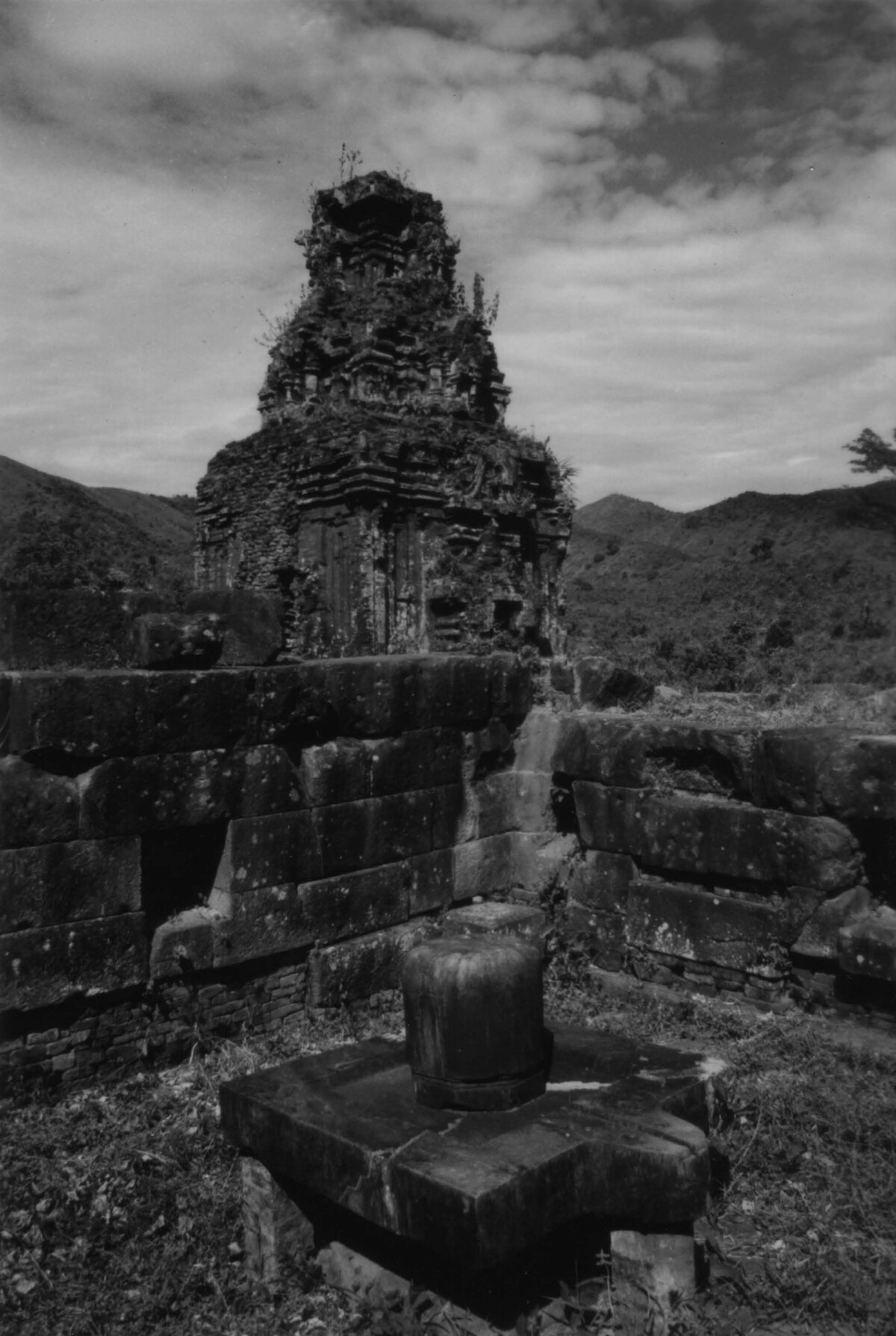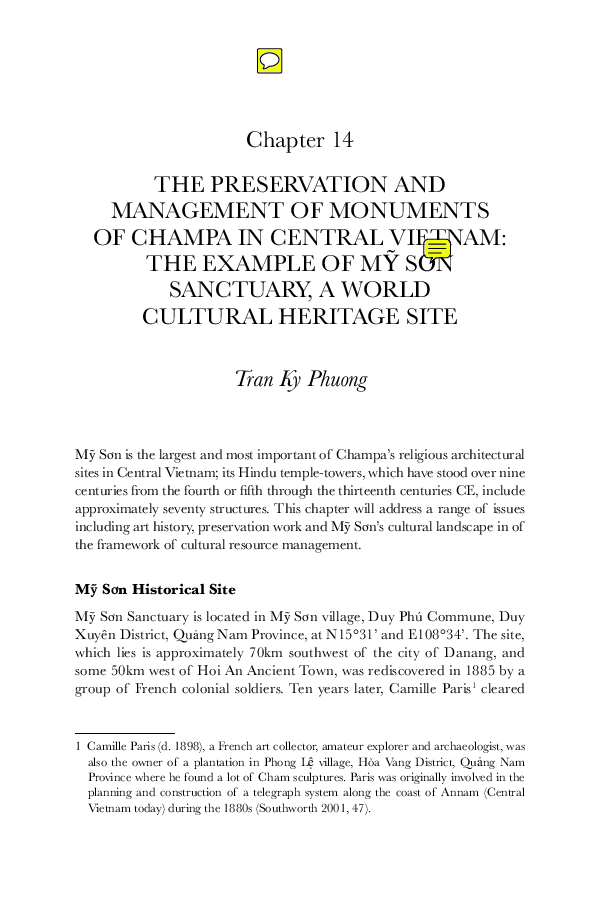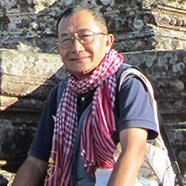“The My Sơn complex contains a wide range of unique architectural styles and decorative motifs; it too benefited from a technological tradition ofbuilding in brick that attained perfection over many centuries of adaptation and improvement’ ”notes the author, adding: “Although the Cham did not build any large monuments resembling those of Angkor, Cambodia or the Hindu-Buddhist stone temples of Central Java (Indonesia), the architectural works of My Sơn reflect the subtle sense of beauty and exquisite talent of Cham artists over many generations. These artists skillfully combined perfect building techniques and refined artistry and they created magnifi cent and solemn beauty in their brick temple-towers at My Sơn.”
The earliest inscription of My Sơn Sanctuary was set up by King Bhadravarman (Pham Ho Ðat in Vietnamese, or Fan Hu-ta in Chinese historical records) during c. 380 – 413 CE.
As for sustainable tourism and involvement of local communities in the site preservation, the author notes: “The number of tourists visiting the Cham monuments is increasing. In recent years, the My Sơn site has received approximately 150,000 visitors yearly, over half of whom are foreigners. Proper preservation of Champa monuments is a major consideration for Vietnamese authorities who need to learn more from international experts, especially those from ASEAN who have the most experience in the preservation and management of historical sites in Southeast Asia. Among activities created for tourists, the management board of My Sơn Site has arranged for the Chăm from Ninh Thuan Province as well as local inhabitants to stage performances of music and dances adapted from traditional Chăm music and folk dance. These activities attempt to recreate the atmosphere of Chăm culture at a religious site which has been abandoned for a long time. Several annual festivals are associated with Cham temple towers.”
ADB Input: According to the author, “My Son site was rediscovered in 1885 by a group of French colonial soldiers. Ten years later, Camille Paris {Camille Paris (d. 1898), a French art collector, amateur explorer and archaeologist, was also the owner of a plantation in Phong Le village, Hòa Vang District, Qung Nam Province where he found a lot of Cham sculptures. Paris was originally involved in the planning and construction of a telegraph system along the coast of Annam (Central Vietnam today) during the 1800s) cleared the site and between 1896 and 1899, Louis Finot and Etienne Lunet de Lajonquière came to My Sơn to do research on the Cham inscriptions found there. In 1901 – 2, Henri Parmentier studied Cham art and in 1903 – 4, along with Charles Carpeaux, he carried out archaeological excavations in My Sơn. These activities culminated in 1904 with Finot and Parmentier’s article published in the Bulletin de l’École Française d’Extrême – Orient (BEFEO).”
In the Brebion-Cabaton Dictionnaire bibliographique, we can find more information about this Camille Paris, an interesting figure who published a pamphlet against the Christian missionaries (L’oeuvre néfaste des
missionnaires en Indochine, with A. BARSANTI, Paris, Le Papier, 1905, in-16): “Né à Lunéville le 10 septembre 1856. Mort en Annam, d’une flèche, dans la province de Binh-Dinh fin janvier 1908. Arriva en Indochine comme soldat d’infanterie de marine. Sergent, il fut nommé employé des postes et télégraphes. Il fut chargé d’établir la ligne télégraphique Saïgon-Hué. Il était receveur des postes à Tourane en 1894 ; il donna sa démission pour se livrer à la culture dans la même province (1895) où à Phong-Lé, à quelques kilomètres au sud de Tourane, il fonda une plantation de caféiers sur l’emplacement de laquelle il trouva des vestiges de monuments chams. En juin 1896 reçut mission du Ministère pour la recherché des Monuments chams en Annam. Mission qu’il accomplit du 16 décembre 1896 au 12 juin suivant, recherchant la frontière septentrionale de l’ancien Champa. Dans son abrégé
de l’histoire d’Annam, il pilla sans vergogne les notes de TRUONG VINH-KY (voir ee nom) sans, bien entendu, citer son nom. Il fut président du Syndicat des producteurs et exportateurs de Tourane. De caractère et de tempérament désagréables, vaniteux et versatile. Etant en exploration dans les premiers mois de 1908, sa violence, sa brutalité lui valurent de succomber sous la flèche d’un sauvage. Il publia de nombreuses diatribes haineuses et grotesques eontre les Missionnaires, ce qui lui valut une verte et spirituelle réponse du P. GUERLACH, qui le convainquit de mensonge et d’ignorance.” [Born in Lunéville September 10, 1856. Died in Annam, killed by an arrow, in the province of Binh-Dinh at the end of January 1908. Came to Indochina as a Marine infantryman. Sergeant, he was appointed postal and telegraph employee. He was responsible for establishing the Saigon-Hue telegraph line. He was postmaster of Tourane in 1894; resigned to engage in cultivation in the same province (1895) where in Phong-Lé, a few kilometers south of Tourane, he founded a coffee plantation on the site of which he found remains of Cham monuments. In June 1896, received a mission from the Ministry for the search for Cham Monuments in Annam. Mission he accomplished from December 16, 1896 to the following June 12, seeking the northern border of former Champa. In his abridgment of Annam’s history, he shamelessly plundered the notes of TRUONG VINH-KY without, of course, mentioning his name. He was president of the Syndicate of Producers and Exporters of Tourane. Unpleasant character, vain and versatile. Being in exploration in the first months of 1908, his violence, his brutality earned him to succumb under the arrow of a native. He published many hateful and grotesque diatribes against the Missionaries, which earned him a sharp and witty response from Fr. GUERLACH, who exposed his lies and ignorance.”
He published quite extensively, nevertheless:
- Le Tong-king : Usages et coutumes (Bull.” Soc. géog. de l’Est, 4e trim. 1885, 1er trim. 1886, T. VII et VIII).
- Itinéraires en Annam (Bull. Soc. géog. de l’Est, 2e, 3e, 4e trim. 1886, T. VIII).
- Voyage d’exploration de Hué en Cochinchine par la route mandarine,. Paris, E. Leroux, m‑8, 6 cartes, 12 grav., 1889.
- Les ruines tjames de Tra-Kéou, prov. de Quang Nam (Annam) (L’Anthropologie, t. II, p 283), 1891.
- Les ruines tjames de la prov, de Quang Nam (Tourane) (L’Anthropologie, t. III, p. 137), 1892.
- Les stations de My-son, Tra-keu, Phong-lé (Bull. géog. hist. et descript., p. 69), 1902.
- Le Klumh-Hoa (Soc. géog. de l’Est, ze trim. 1888, T. 20).
- Au Blnh‑D}nh (Soc. géog. de l’Est, 4e trim. 1888, 4e trim. 1889). .
- Cartes itineraires de Hué au Binh Thuan avec notices historiques et géographiques, Pans, E. Leroux, br. m‑8, 1889.
- Les ruines Tchames de Tay-Loc (Mémoire, Manuscrit et 6 photog.) (Bull. géogr. Paris, 1894).
- Découvertes archéologiques récentes dans la province de Quang-Nam (Bull. Géog. hist. et anecd., 1896).
- Rapport; sur une Miss!on archéologique en Annam (Extr. Bull. géog. hist. et descripl., n 2, 1898). Paris, Impr. nat., m‑8, 1899.
- Itinéraire de Hué en Cochinchine par la route mandarine. Paris, 1899.
- Abrégé de l’Histoire de l’Annam. Hanoï, Schneider, 1891.
- L’Annamite, ses caractères ethniques (Anthropol., T. II, mars-avril 1891).
- Le thé d’Annam. Hanoï, Le Vasseur, br., 1894.
- Le café de l’Annam. Tourane, chez l’auteur, in-16 br., 1895.
- Incendies périodiques des montagnes d’Annam, dommages qu’ils causent à l’agriculture et calamités qu’ils préparent au pays (Bull. Soc. géog. comm. Paris, 1896).
- La création d’un établissement agricole et commercial au Dak Joppau, province de Binh-Dlnh (Tonkin) (Bull. Soc. géog. comm. Paris, 1899).
- L’oeuvre néfaste des Missionnaires en Indochine, op. cit.



